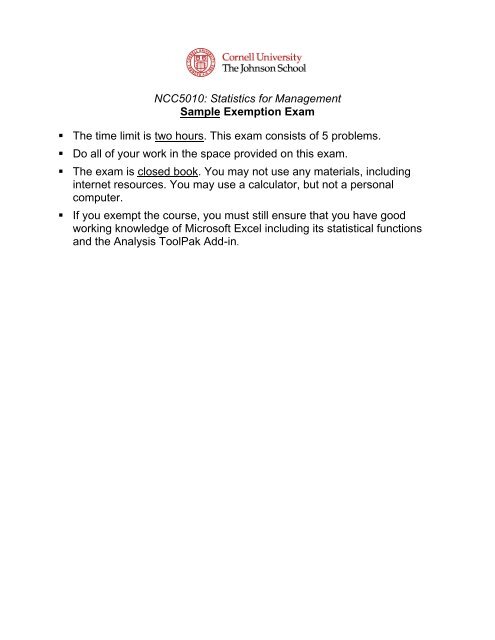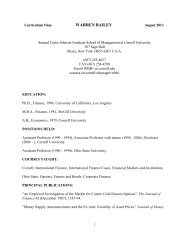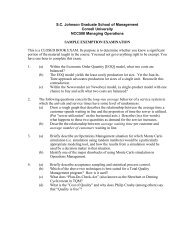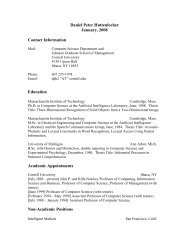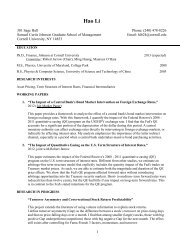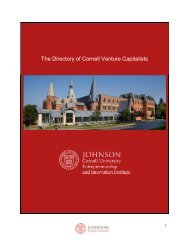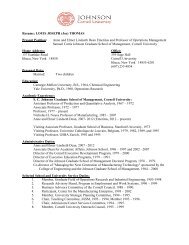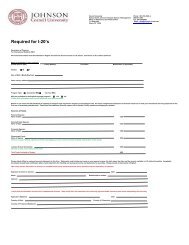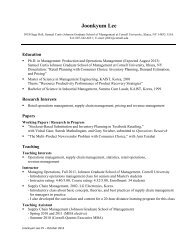NCC5010: Statistics for Management Sample Exemption Exam The ...
NCC5010: Statistics for Management Sample Exemption Exam The ...
NCC5010: Statistics for Management Sample Exemption Exam The ...
You also want an ePaper? Increase the reach of your titles
YUMPU automatically turns print PDFs into web optimized ePapers that Google loves.
<strong>NCC5010</strong>: <strong>Statistics</strong> <strong>for</strong> <strong>Management</strong><strong>Sample</strong> <strong>Exemption</strong> <strong>Exam</strong>• <strong>The</strong> time limit is two hours. This exam consists of 5 problems.• Do all of your work in the space provided on this exam.• <strong>The</strong> exam is closed book. You may not use any materials, includinginternet resources. You may use a calculator, but not a personalcomputer.• If you exempt the course, you must still ensure that you have goodworking knowledge of Microsoft Excel including its statistical functionsand the Analysis ToolPak Add-in.
<strong>NCC5010</strong> <strong>Sample</strong> <strong>Exemption</strong> <strong>Exam</strong>1. a) A manager has assessed the likely range of sales (in $ million) and assigned a probability toeach, based on past experience and market research. <strong>The</strong> table below shows this in<strong>for</strong>mation,along with the profits (in $ million) that would accrue. Find the expected value of profits.Sales Probability Profit40 0.3 850 0.1 960 0.6 11b) Given the following joint distribution of two random variables X and Y. What is the probabilitythat Y = 5 given that X = 56? Are the random variables independent?X=34 X=56Y=2 0.2 0.1Y=5 0.4 0.3
<strong>NCC5010</strong> <strong>Sample</strong> <strong>Exemption</strong> <strong>Exam</strong>2. Several probability distributions are common in business situations.a) Describe a situation in which the Binomial probability distribution may be used.b) What assumptions must be satisfied to use the Binomial distribution?
<strong>NCC5010</strong> <strong>Sample</strong> <strong>Exemption</strong> <strong>Exam</strong>3. 400 stocks were selected at random. Of these, 75% declined in value during the month of July.Based on these results, the 99% confidence interval is from 69.4% to 80.6%. Explain what thisinterval means.
<strong>NCC5010</strong> <strong>Sample</strong> <strong>Exemption</strong> <strong>Exam</strong>4. A manager wants to test whether parts manufactured using a new process have fewer defectsthan when the old process is used. One sample was collected under the old process, and asecond sample under the new. <strong>The</strong> fraction of defective items in the two samples is to becompared by a statistical test.a) Should the statistician use a one-tail test or a two-tail test? Explain.b) State the null and alternative hypotheses in English.c) Once the statistical test has been done, there are two possible types of errors that canoccur. Describe them in English.
<strong>NCC5010</strong> <strong>Sample</strong> <strong>Exemption</strong> <strong>Exam</strong>5. Suppose a regression analysis results in the following estimated equation:. Y = 10 + 4X 1 + 5X 2 – 2X 3(Y = unit sales, X 1 = advertising (gross rating points), X 2 = size of sales <strong>for</strong>ce,X 3 = price in constant dollars.)a) Explain, by example, how an advertising manager might use such results.b) Describe two measures of goodness-of-fit that computers report <strong>for</strong> regression analyses.Assuming that a computer had given you the values <strong>for</strong> both of these measures, explain (byexample) how you could use them in the above example.c) How would the advertising manager decide if the coefficient of X 1 (given above as 4) issignificantly different from zero? (What additional statistic is required and how is it used?)d) In order <strong>for</strong> statistical tests such as in Part (c) to be valid, what assumptions are required,and how would you determine whether these assumptions are satisfied?


